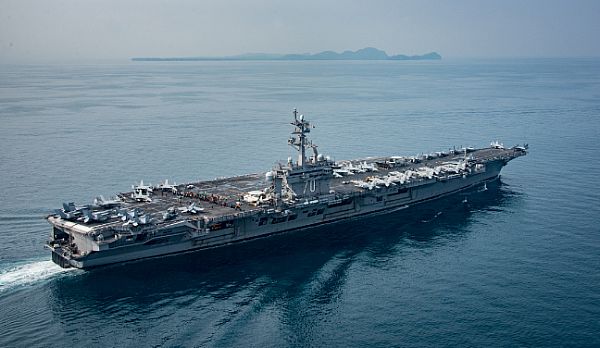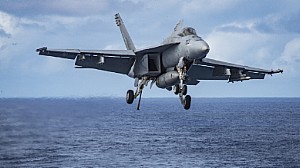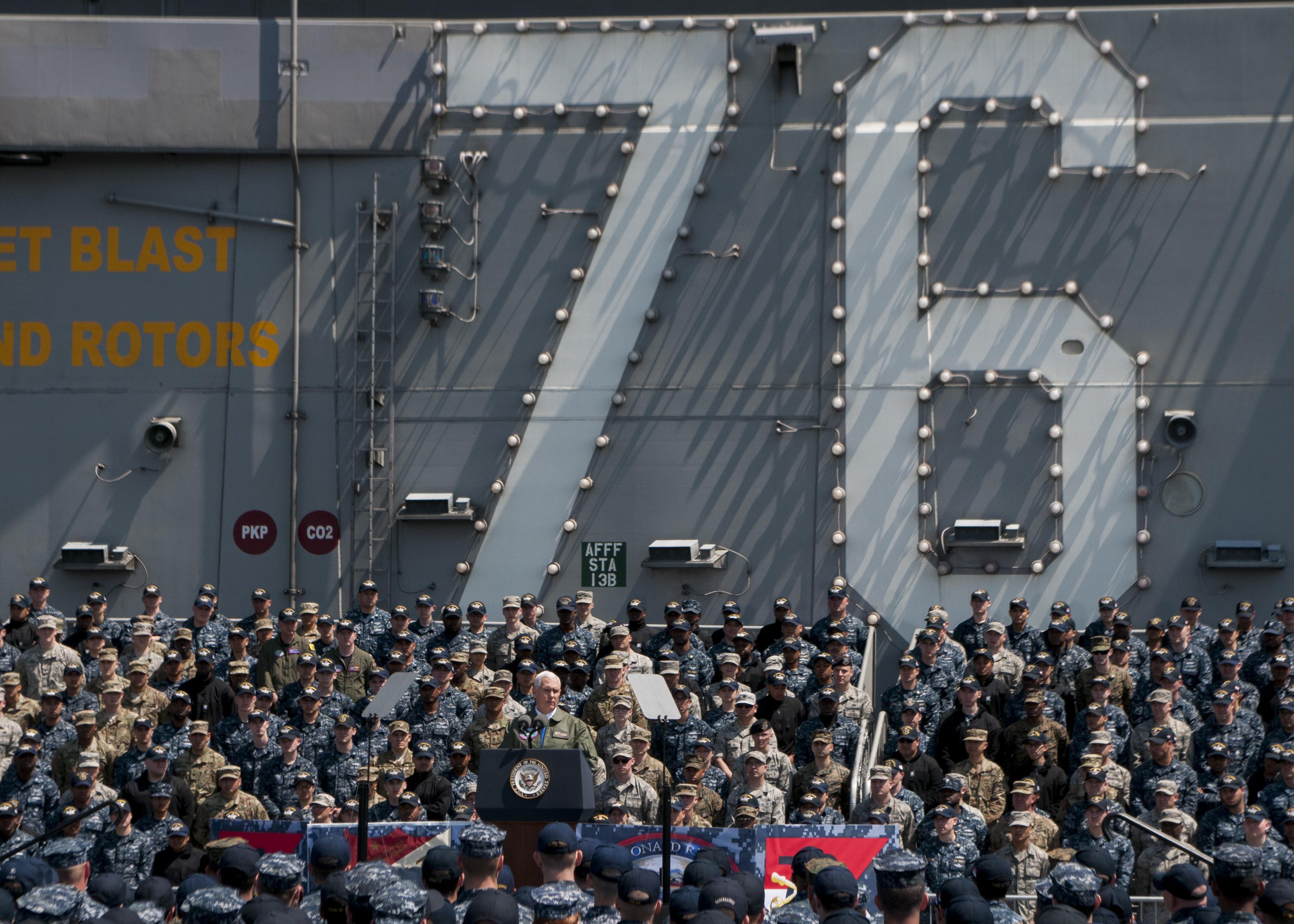
UPDATE IV:
Good Ending
Defense Department:
A pilot safely ejected and was quickly recovered by a helicopter assigned to Helicopter Sea Combat Squadron 4 aboard USS Carl Vinson while conducting routine flight operations during a transit in the Celebes Sea.
The incident occurred as the F/A-18E assigned to Carrier Air Wing 2 was on final approach to Carl Vinson.
The incident is currently under investigation. The pilot is being assessed by the medical team aboard Carl Vinson and there are no apparent injuries at this time.

Official U.S. Navy file photo of an F/A-18E Super Hornet Strike Fighter on final approach for an arrested landing aboard the aircraft carrier USS Carl Vinson (CVN 70). (U.S. Navy photo by Mass Communication Specialist 2nd Class Sean M. Castellano)
UPDATE III:
The Carl Vinson Strike Group has finally turned around, finally heading to its previously heralded destination “as a prudent measure,” and is promised to arrive off the Korean Peninsula by the end of April, according to defense officials.
In the meantime other prudent and not-so-prudent actions and events are taking place on the Peninsula.
Among the prudent measures, our forces are preparing for all contingencies, including reports that the U.S. Air Force has sent a WC-135 Constant Phoenix aircraft towards the Korean Peninsula.
The WC-135 aircraft (a “nuclear sniffer” aircraft) is used to “collect samples from the atmosphere to detect and analyze nuclear explosions.” It should be noted that the U.S. Defense Department does not comment on such deployments.
U.S. and South Korean air forces are conducting join exercises, codenamed Max Thunder, until April 28.
Of course, our forces in the region have been at increased readiness levels for a time.
Under the “not-so-prudent” — preposterous might be a better term — category, the North Korean regime is threatening, according to Reuters:“In the case of our super-mighty preemptive strike being launched, it will completely and immediately wipe out not only U.S. imperialists’ invasion forces in South Korea and its surrounding areas but the U.S. mainland and reduce them to ashes…” along with videos depicting the nuclear destruction of the United States.
Even South Koreans have been annoyed at the Trump administration for recent gaffes, including the whole Carl Vinson “affair” (below), and for what are called Trump’s “ignorant remarks” that Korea was once “part of China.”
Finally, in the “what does this mean?” category is the Reuters report that a “higher-than-usual level of activity by Chinese bombers” has been taking place signaling a heightened state of readiness by China.
UPDATE II:
Apparently, the South Koreans are not very happy with the Trump administration screw-up on the Carl Vinson-led Carrier Strike Group.
Hong Joon-pyo, the leading candidate for the Saenuri political party who “could very well be the next leader of South Korea as the country prepares to hold elections,” criticized Trump “for not taking their national security seriously,” according to occupydemocrats.com.
In a recent interview, Joon-pyo slammed Trump, “What Mr. Trump said was very important for the national security of South Korea. If that was a lie, then during Trump’s term, South Korea will not trust whatever Trump says,” according to the Wall Street Journal
UPDATE I:
Asked about the Carl Vinson gaffe during an interview with CNN aboard the USS Ronald Reagan aircraft carrier, at the U.S. Yokosuka naval base in Tokyo Bay, whether the statements about its location and course had been intentional, the vice president replied, “oh, I think not.”

Vice President Mike Pence addresses service members aboard the aircraft carrier USS Ronald Reagan in Yokosuka, Japan, April 19, 2017. Navy photo by Seaman Frank Joseph Speciale
Pence praised the service members aboard the USS Ronald Reagan. “You are the sons and daughters of freedom willing to defend it with your life so that your families, fellow countrymen and future generations may continue to call themselves free. All of America is proud of you.” The vice president also told the sailors and Marines, that they are “the best of us, heroes all. The Americans among you are so far away from home because the United States of America and Japan are bound by history, a time-honored treaty and the abiding oath of friendship.”
In the meantime, California Rep. Adam Schiff has called the Carl Vinson episode “more than embarrassing” for the U.S.
“Because, of course, if the provocation of saying that caused the North to react and we didn’t have our capabilities in the region, that would compound the problem,” he explained on “CBS This Morning,” where he framed Pyongyang’s potential to miniaturize a nuclear device and put it on an intercontinental ballistic missile as “probably the most serious national security crisis this president is gonna face.”
“That point will probably come during this four-year term of the president, so that challenge is coming if something doesn’t change,” he warned.
Original Post:
As yours truly, along with virtually the entire media, was proclaiming that the powerful Carl Vinson Strike Group was approaching the Korean Peninsula, the floating armada was in fact two or three thousand miles away from Korea. As a matter of fact, at one time the Strike Group was “sailing in the opposite direction, to take part in joint exercises with the Australian Navy in the Indian Ocean, 3,500 miles southwest of the Korean Peninsula,” according to the New York Times.
The New York Times:
White House officials said on Tuesday they were relying on guidance from the Defense Department. Officials there described a glitch-ridden sequence of events, from a premature announcement of the deployment by the military’s Pacific Command to an erroneous explanation by Defense Secretary Jim Mattis — all of which perpetuated the false narrative that an American armada was racing toward the waters off North Korea.
By the time the White House was asked about the Carl Vinson on April 11, its imminent arrival had been emblazoned on front pages across East Asia, fanning fears that Mr. Trump was considering a pre-emptive military strike on North Korea. It was portrayed as further evidence of the president’s muscular style two days after he ordered a missile strike on Syria while he and President Xi Jinping of China were finishing dessert during a meeting in Florida.
How did this snafu come to light?
The saga of the wayward carrier might never have come to light, had the Navy not posted a photograph on Monday of the Carl Vinson sailing through the Sunda Strait, which separates the Indonesian islands of Java and Sumatra. The picture was taken on Saturday [April 15], four days after the White House press secretary, Sean Spicer, described its mission in the Sea of Japan.
Rest easy, however, “The Carl Vinson is now on a northerly course for the Korean Peninsula and is expected to arrive in the region sometime next week.”
As has become normal for this White House when things go awry, it is referring all questions to the Pentagon.
Lead photo (Note the date) SUNDA STRAIT (April 15, 2017) The aircraft carrier USS Carl Vinson transits the Sunda Strait. (U.S. Navy photo by Mass Communication Specialist 2nd Class Sean M. Castellano)
CODA: This misunderstanding at the White House level should in no way reflect on the fine officers and sailors of the Strike Group. They were, no doubt, following their orders.
















